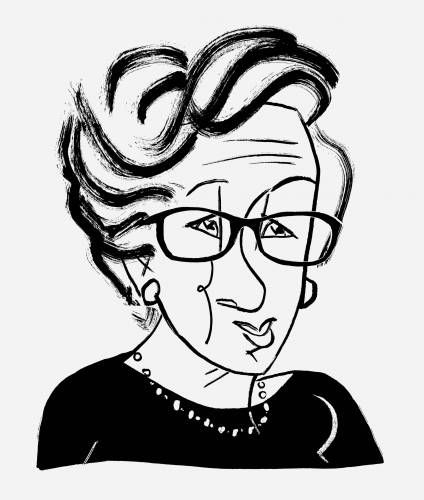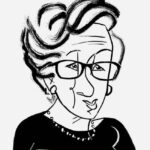Not long ago, Eva Schloss, a survivor of the Holocaust and a childhood friend of Anne Frank’s, left her home in London and flew to Los Angeles, where she spent a week inside a camera-filled dome, answering painful questions about her past. “It was exhausting—the lamps and the cameras and the big globe,” she recalled. In a soft accent, she explained, “We are really worried. We won’t be here very much longer to answer questions.”

Eva SchlossIllustration by Tom Bachtell
In 1938, Schloss’s family left Vienna for Amsterdam, where she met Anne Frank, and later went into hiding. When she was fifteen, her family was taken to Auschwitz-Birkenau, and she spent nine months in the camp. Her father and her brother were killed in a death march. In 1953, her mother married Otto Frank, Anne’s father, and Schloss became a kind of “posthumous stepsister” of Anne’s, she said. In L.A., Schloss recounted these facts to a hundred and sixteen video cameras, which photographed her from all sides, and logged some fifteen hundred of her patient answers. The recordings were used to develop an artificial Eva Schloss, housed inside a screen, which schoolchildren might question years from now.
On a recent Monday, the flesh-and-blood Eva Schloss stopped by the Museum of Jewish Heritage, in Battery Park City, to meet her digital counterpart. She wore a cardigan and pearls, and arrived with Heather Maio-Smith, from Conscience Display, which helped build the doppelgänger.
“Have you seen it already?” Schloss asked, beaming. “I haven’t seen it in action yet.”
“The museum did an excellent job,” Maio-Smith said. She was wearing a black sweater and her hair was in a ponytail.
Up on the museum’s second floor, in a large room filled with benches, a mounted screen showed the artificial Eva Schloss seated on a chair. She appeared three-dimensional from the front, and held her hands folded in her lap. She gazed out expectantly. Occasionally, she flashed a shy smile.
The real Eva Schloss approached, tentatively. “It feels funny,” she said, and laughed nervously.
Maio-Smith clicked a mouse on a podium. “Good morning,” she said.
“Good morning,” Artificial Eva answered. Her voice was unexpectedly loud.
Maio-Smith turned to Schloss. “Do you want to ask a question? You press this when you’re talking.”
“Oh, I see,” Schloss said, and turned toward the screen. She spoke slowly, as if coaxing a child. “So, hello. I think I do know you. Do you know me?”
“Hello,” Artificial Eva said.
Maio-Smith prodded Schloss: “Do you remember any of the questions?”
“I don’t, but I can make up another one,” Schloss said. “How long were you in the camp?” she asked.
“I was moved to Auschwitz when I just turned fifteen years old, and I came out when I was still fifteen, and I was there for nine months,” Artificial Eva answered.
“Yes, correct.” Schloss nodded. She considered her image. “I look a bit white and a bit sad. I’m not always sad.”
“You’re laughing!” Maio-Smith protested.
“It’s good that I move a bit,” Schloss said. “You ask one,” she told Maio-Smith.
“Can you tell me about your brother?” Maio-Smith asked the screen.
“Well, of course it was different when I was little, and when I was starting to go to school,” Artificial Eva began. “I didn’t like to go to school; I didn’t want to learn anything. I always wanted to play.”
Schloss looked at Maio-Smith. “Not really the answer, eh?” she said.
Maio-Smith tried again. “What was your relationship with your brother like?”
Artificial Eva was ready for this one. “We had a very, very close relationship,” she said. “He was a very protective kind of boy.” He would tell her the plots of books he’d read, about Indians, and travelling to the moon, and submarines, and the deep sea. “He was a wonderful storyteller. He said, ‘I can make Eva cry within five minutes.’ He told me a story that he was an old man, and he was very ill, and he couldn’t walk anymore, and then he died—and I burst into tears,” she said, smiling.
Schloss had been listening intently. “Yes, that was a good story,” she said.
Maio-Smith said that, thanks to natural-language-processing software, Artificial Eva was getting steadily better at responding to visitors. “The thing that kids like about talking to you in this form is that they don’t have to be worried about what they ask you.”
“They’re embarrassed?” Schloss asked.
“They don’t want to make you upset,” Maio-Smith explained.
Schloss turned toward the screen and asked, quietly, “Do you have a number? On your arm, tattooed?”
“I have a tattoo,” Artificial Eva said. “My number is A, fifty-two, twenty-two.”
Schloss, even more gently: “Do you think I could see your number?”
“I live in England, in London,” Artificial Eva responded.
Maio-Smith tried. “Can you show me your tattoo?”
“Ah, yes, you can see that.” Artificial Eva rolled up her sleeve and pointed to her forearm. “There was a number on top here.”
“Thank you very much,” Schloss said. “Because some people don’t like to ask.” ♦
Sourse: newyorker.com


